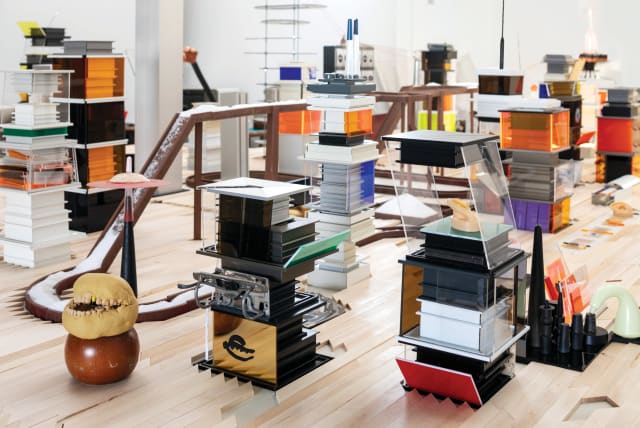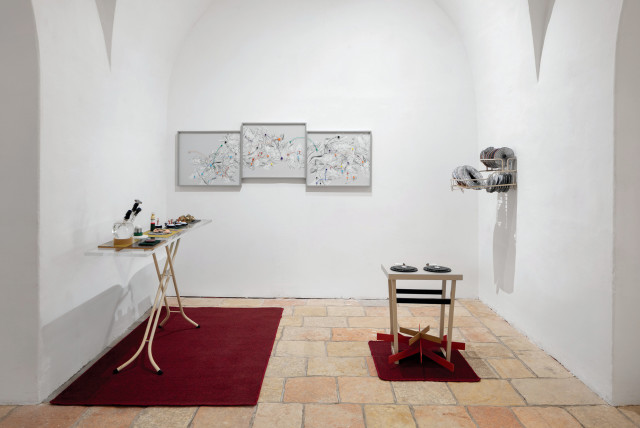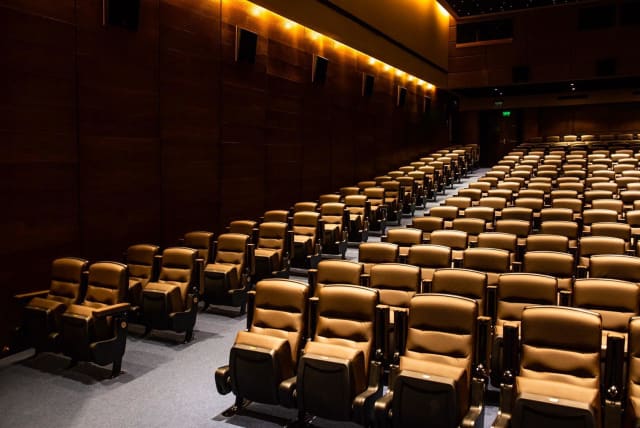If you want to get a good handle on life, whatever your take, it makes sense to break things down into more easily manageable parts. Guy Goldstein followed just that avenue of thought in putting together his multifaceted, broadly roaming, installation-based “Smart Home in a Dumb Body” exhibition, which opened at Hansen House earlier this week under the curatorship of Vardit Gross. The show was originally scheduled to kick off on October 13, but Hamas had other ideas.
This is a highly complex work with numerous components, some moving, some transparent, others simply quizzical. Everywhere you look, there are instantly recognizable objects which somehow look out of place. That’s probably because they are. The dissonance keeps you guessing. You zoom in on a familiar hook before you realize that things are not at all the way you expected them to be.
The new offering, in fact, started its gestation period a year ago when Goldstein exhibited an extensive installation with a similarly beguiling title – “Finger Foods and Future Mistakes.” There, too, he assembled a motley spread of objects, both in their basic form as well as refashioned into sculptural items, investing them with added aesthetic and intellectual value by creating surprising confluences and juxtapositions.
That also resonates across “Smart Home in a Dumb Body” with its seeming common or garden artifacts and objects positioned in unexpected spots, with surprising elements – dismembered body parts or weirdly shaped plates, for example – providing thought-provoking tangential asides all over the place.
The home lies at the core of the work, although not quite in the traditional meaning of the term. The base residence format is the smart home with all mod cons and advanced gizmos designed to make the occupants’ lives easier and more efficient. Goldstein casts a sober look on the human-technology interface and, as the exhibition moniker implies, is not too impressed with our current everyday level of performance.
In fact, the philosophy behind the exhibition takes a critical stab at the way things are evolving here in terms of ecology, individual freedom, and basic quality of life. The dystopian perspective, as mentioned, began to emerge last year.
“[Hansen House artistic director] Karine [Shabtai] asked me to create a continuation to ‘Finger Foods and Future Mistakes,’ which I exhibited at Artport [gallery in Tel Aviv] last year,” Goldstein explains. Gross serves as director and chief curator of that establishment. “That was a kind of abstract model of all sorts of objects that related to post-corona and post-social distancing in a sort of encounter with the mistakes of the 20th century. It posed the idea that we are now paying for those errors.”
There’s no mistaking that, certainly in plain ecological terms. But not just. “There is pollution, the geopolitical state of the world, the climate crisis, technology.”
GOLDSTEIN WANTS us to get away from the bling-bling sheen of the consumer market and political rhetoric and to see things for what they really are. This includes the undeniable sad fact that while technology advancements may facilitate basic necessities for now – such as keeping in touch with each other, wherever we may be across the globe – we are also compromising our privacy. Cellphones are easily monitored and tracked by authorities with the necessary means and a watchful eye, and our Internet use can be kept under surveillance.
The Big Brother aspect of modern-day living is alluded to in the Hansen House centerpiece, for example, by the tall watchtower in the varified assemblage. There is also a perimeter fence that runs around the tabletop. There appears to be no way out. “There were all these fantasies of a brilliant future, but that doesn’t seem to be so brilliant now,” Goldstein suggests.
There is also a clear statement here about urban development and the proliferation of tall buildings in all our cities. Perhaps that is most keenly felt in Jerusalem, where the skyline has jumped heavenward in incremental leaps and bounds in the past decade, with plenty more planned.
“The city is closing in on us,” Gross declares. “The buildings are gaining in height, limiting our view of the sky, cramping our lungs” – which, she believes, also impacts on our indoor living space. “Inside the apartment, it is becoming increasingly difficult to breathe. Technology strives upwards, towards the future, but out of the windows of our home, there is an apparent sense of an apocalyptical present, of an approaching disaster.”
When quality of life get worse
Gross says “Smart Home in a Dumb Body” warns of that inexorable sense of loss of control and a depressing downward spiral towards a vastly inferior quality of life. “In a one-person apartment, constructed inside the Hansen House gallery, Guy Goldstein examines the relationship between the city and society and the political, social and material steps that shape it. He considers the permanent exhibition of Hansen House, which tells the historical tale of the leper shelter, and creates in the gallery spaces a contemporary collection of rooms, which also addresses issues of loss and loneliness.”
The venue for the follow-up to the Artport date, says Goldstein, required some thought and planning. Hansen House dates back to the 19th century, long before hi-tech innovations made their pervasive presence felt in every walk of life. Hence the red-mauve strips of carpet that lead the visitor into the main and side display areas. “The flagstones here are from a past era,” says the artist, “so I thought I should cover them a bit.”
They also serve to imbue the setting with a homey feel as we tread our way into the different spaces that reflect a domestic layout, complete with bedroom, bathroom, kitchen, and living room – of sorts. Nothing as we now know is at it seems. And every item in the exhibition plays an individual and interplay role in drawing us into the creative subtext and keeping us wondering what it’s all about.
In case you forget what you’ve just seen in one section of the gallery, there are repetitive thematic references to various minutiae along the way. The plates on the drying rack in the kitchen area, for example, are all shapes and sizes, some with irregular gaps in the middle. That resonates with the odd, similarly shaped items elsewhere in the installation and with pieces that Goldstein describes as cymbals.
IT WAS interesting to note that Goldstein is also a musician, as there are various sonic slots around the place. The bedroom, for instance, has an oddball contraption that comprises something that looks like a radio speaker of old, an antenna, and an appendage that swings back and forth intermittently. There is also a low humming-buzzing soundtrack to the affair, again suggesting that all may not be well with the world.
And the bed’s mattress is, in fact, an electronic digital screen with lines of unintelligible characters, or letters, flowing across it. “That might remind you of those convenience stores with their digital messages advertising various products,” Goldstein says. “This is a deconstruction of language, of the words,” he says, in a reprise of the dissect-and-rearrange spirit that runs through the whole work.
Oxymoronic juxtapositions pop up here and there, such as the rows of coconut-shaped objects made of human hair, sitting next to a hookah inside a 1950s-style wooden cabinet. The living room section is completed by a corporeal-ethereal hybrid cupboard arrangement with a drawing of a jacket hanging from a hanger in the rear. And, just to complicate matters while adding a tongue-in-cheek dimension, there is also a real hanger. The weird and wonderful configuration has one more human hair coconut with a straw at the front.
Much of the installation invokes a suggestion of audience participation although, in fact, the artifacts are off limits. Despite the fact that the jacket is evidently not real, the actual hanger, which, from a suitable angle appears to fuse with the drawing, one is tempted to reach out and do the deed. “If you can reach it,” Goldstein laughs. You can’t, naturally.
There is so much to see and ponder all over the show. Why, for example, is there a bridge-chute structure with salt spilling over the sides in the main section? “Salt is used as a preserving agent. But what is it supposed to preserve? Perhaps to rub salt into our wounds,” Goldstein proffers with a resounding chuckle. There are also rectangular structures with thin sides reminiscent of apartment blocks, with a possible nod towards Japanese residences with sliding latticework wood and rice paper partitions.
The coconut raw material also connects with the other body parts dotted around the spread. There are mouths, ears, feet, a forearm, an alluring hand, and eyes. The latter play a leitmotif role, particularly in the bedroom, which has a framed work on the wall with dozens of eyeglass lenses. Linear, circular, and disheveled-looking wiggly designs can be espied through the lenses, with three or four strategically placed eyes, giving the impression of either a view of some largely obscured space on the other side or a less-comfortable sense of being watched. Just to add to the unease, several tiles on the bathroom wall also sport eyes. Adding to the quirky nature of the work, the centerpiece assortment has a miniature brain sitting on a foot. All the grist to the whirring cerebral wheels.
“If I can, I introduce some distortion to the original function of any implement, or make things difficult for it – like with the plates in the kitchen,” says Goldstein. “Here you see the digestive system on this plate. I like to have comic elements in my work, too.” The humor is generally of the darker variety.
Sociopolitical critique notwithstanding, “Smart Home in a Dumb Body” is an inviting aesthetic and sensorial proposition. There is lots to see, query, and ruminate upon. And despite the vast number of components, one doesn’t feel overwhelmed. There is space to ebb and flow between the sections and get a good look at any and every piece, as takes one’s fancy.
Size also plays an important part in conveying the artist’s message of impending mayhem. “The dimensions of the anatomical parts and the buildings are reversed,” Goldstein notes. “And the buildings aren’t very functional. They are like the concrete blocks with some coating they put up these days.”
As war rages on, and in the wake of October 7, “Smart Home in a Dumb Body” tragically takes on even more relevance, as a pervading sense of disorder and the absence of a responsible, caring guiding hand hangs over us like a pall of dense smoke – and foreboding. ❖
‘Smart Home in a Dumb Body’ closes on January 1, 2024. For more information: hansen.co.il/en/








































































































